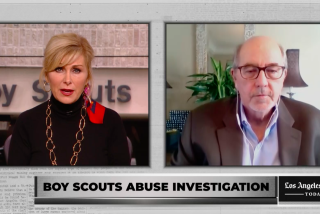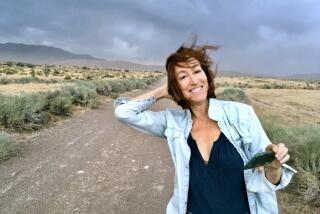The Right Chemistry : Authors: Deborah Blum parlayed her science background and reporting skills into a book that investigates both sides of the controversy over the use of primates in biomedical research.
- Share via
BERKELEY — Her father, a well-known entomologist, dearly wanted her to follow in his scientific footsteps, but Deborah Blum realized early on that she wasn’t cut out for bug-hunting or, for that matter, any other sort of research career.
While trying to cope with freshman chemistry, she nearly set the lab on fire when she knocked over a Bunsen burner. “Klutzes don’t make very good scientists,” Blum says with a chuckle as she deftly scoops up a bit of polenta during the prerequisite author’s lunch at Chez Panisse, Berkeley’s temple of California cuisine. “Much to my father’s regret, I decided then and there I’d be much happier as a reporter.”
Nowadays Blum has plenty to be happy about. Not only has the jittery, young would-be chemist become a highly accomplished science reporter, but she’s just capped her career with a provocative new book--her first--that brilliantly tackles one of the thorniest issues of contemporary science.
Even the formerly skeptical Prof. Murray Blum is impressed. “He’s of the old school,” says his first-born (of four daughters). “He believed scientists should talk only to other scientists, not to reporters, though I think I’ve finally won him over.”
Titled “The Monkey Wars” (Oxford University Press), Blum’s tale is a riveting, fast-paced study of the raging public controversy over the use of primates in biomedical research--experiments that, in spite of the best intentions, often leave them maimed, mutilated or dead.
In a highly laudatory review, John Carey, biomedical correspondent for Business Week, wrote: “I guarantee that whatever your current beliefs may be, ‘The Monkey Wars’ will make you see the whole question of animal research--and much that has been done in the name of science--quite differently.”
In less gifted hands, the subject might easily have lapsed into polemics; indeed, the shelves are already filled with such tracts. But Blum is nothing if not scrupulously fair-minded, giving both sides--animal rights activists and the experimenters--their due.
“The challenge is not to be emotional--not to write at the gut level,” she explains.
But that wasn’t always easy. Like her father, she initially had a vague feeling that “all animal rights activists were nuts.” After all, they were engaged in all sorts of nasty behavior--infiltrating labs, disrupting experiments, threatening scientists. But as she delved deeper, she realized that there was plenty to criticize all around. The experience was also emotionally wrenching.
A self-described animal lover who as a 6-year-old growing up in Louisiana wanted to trade her saved pennies for a horse and now owns two tabbies--Mozart and Minerva--Blum was appalled by what she learned while doing her research.
She found scientists slicing into the brains of their doped subjects, severing their nerves, subjecting them to impacts and stress. “It’s hard to justify experiments on creatures that are so smart and so much like us,” she admits. Ultimately, though, she accepts the sacrifice for the greater good it may bring to human health.
*
At 40, Blum is irrepressibly bubbly, with short, dark hair, deep brown eyes and a large, impish smile. But once the conversation turns from mutual pleasantries about journalism to her book, the playfulness vanishes. Reporting is deadly serious for her, and it’s clear she’s a bulldog at it, as one scientist learned to his chagrin. Enchanted by the charming reporter who kept asking about his work, he invited her to dine with his family, only to get a stern warning from Blum when he gave her a friendly goodby hug.
“I told him that even though I was his friend, I would tell his story exactly as I see it,” Blum recalls. “His jaw almost dropped to the ground.”
If there’s a no-nonsense, old-style-gumshoe quality about Blum, it’s because, she says, “that’s where I’m at.”
After receiving her journalism degree from the University of Georgia, where she edited her school paper, she took a reporting job with the Macon (Ga.) Telegraph, covering everything from town politics to raids on moonshiners in the hills.
“I had no qualms about using feminine wiles on the cops to get a story,” she says, without a twinge of feminist self-consciousness. Moving on to the St. Petersburg Times, she quickly had her fill of cops, City Hall and school boards. “Journalism can get very repetitive if you stick with general assignment too long,” she says.
So she decided to specialize. Politics was out; she had experienced enough of political cynicism while serving as a college intern in the Washington office of Sen. Sam Nunn (D-Ga.). Much to her father’s surprise, she decided to give science another crack--as a professional observer.
Enrolling in the University of Wisconsin’s journalism program, she earned a master’s in science writing, submitting a thesis on Charles Darwin. Upon graduation in 1982, she married Peter Haugen, her former editor in St. Petersburg, then signed on as the Fresno Bee’s first environment reporter.
She quickly attracted attention by exposing pesticide problems and the buildup of selenium in the San Joaquin Valley. Two years later, the Sacramento Bee, flagship of the McClatchy chain, beckoned her to become the paper’s first full-time science writer.
“It was one of the better decisions I ever made,” says Frank McCullouch, the chain’s executive editor at the time. “I told the editors that this was the person for the job, and she proved me right. She is one of those rare people who can write with both style and clarity.”
*
Blum soon showed a knack for finding stories in unlikely places. She persuaded her paper to let her do an in-depth investigation of California’s nuclear weapons labs. “I knew there was something of a cowboy culture at the labs and it scared me a little,” she says. “But that’s when you make a real leap in your reporting--I was determined to crack that culture.”
Her prize-winning stories contained some of the first expressions of doubt from within the weapons community itself about the exaggerated public claims being made for the “Stars Wars” anti-missile program.
So it’s not surprising that her editors were willing to listen when she asked vaguely to look at primate research and all the commotion it was causing. They freed her of other responsibilities for nine months while she began tracking down primate researchers. A few opened up to the Blum charm immediately. Others required more cajoling.
“They had been burned severely by all the attacks from animal rights organizations,” she says. “Most wanted to avoid any contact with the press.” After her articles won the 1992 Pulitzer Prize for beat reporting, an alert New York agent persuaded her to turn them into a book. Some reporters might simply have dug out their old notebooks and expanded the jottings. Not Blum. She took a leave from her paper and started the reporting process all over again. Annoyed by her original series, some scientists refused to have anything more to do with her.
“(One scientist) spent more than 45 minutes on the phone with me explaining why he didn’t have time to talk to me,” Blum recalls. Even so, she got what she needed from other sources.
The research and writing took 14 months, during which Blum not only trekked around the country visiting primate labs--”I quickly used up my advance,” she laments--but spent hours poring over neuroscience books to understand the rationale for much of the research.
Responsibility for her son, Marcus, 5, fell largely to her husband, who had meanwhile become the Sacramento Bee’s theater critic. In the midst of all this activity, Blum found herself pregnant.
“We had been trying so long to have another child without success, I guess we must have relaxed our guard,” she says, laughing. Her second son, Lucas, arrived late last spring just as she was reworking the book’s final chapter--”giving it more of a personal perspective,” she says.
Much of the typing was done with one hand as she cradled Lucas in the other for his breast feedings. When she was called to make out-of-town promotional appearances, she left some of her milk behind in the refrigerator. “I became an expert at what I call the ‘cow pump’ ” she jokes.
Indeed, as the Chez Panisse luncheon continues well into the afternoon, her interviewer frets about depriving young Lucas of his meal. “Not to worry,” says the ebullient Blum. “He’s got to be weaned soon.”






